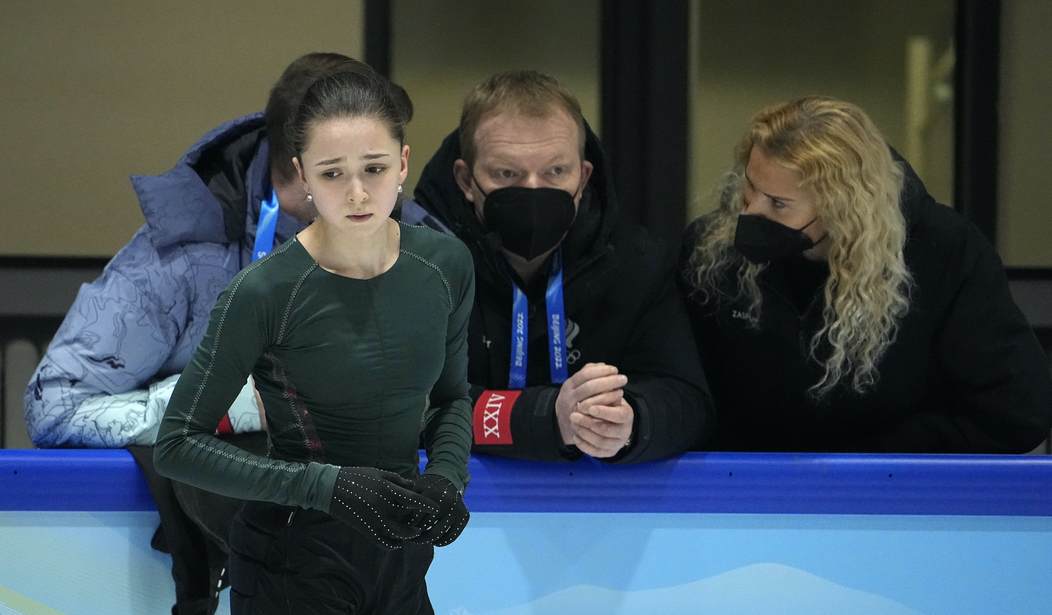I had a strange mix of thoughts when I saw the headline about Kamila Valieva, the 15-year-old Russian figure skater who tested positive for a banned substance at the Olympics in Beijing.
“Valieva, whose first-place performance in the women’s free skate helped secure the Russian’s gold medal, tested positive for trimetazidine, a metabolic drug that helps prevent angina attacks and treats vertigo,” Fox News reports. “It is banned by the World Anti-Doping Agency because it can help endurance and increase blood flow efficiency, both of which could help a figure skater.”
First of all, I wasn’t surprised that the Russians are doping their Olympians again.
And then there’s the fact that she’s only 15! I’m having a hard time imagining my siblings allowing anyone to inject my nieces with illegal substances for any reason other than maybe to save their lives.
But then the biggest thought hit me: why should we care about a teenage girl doping when we have boys and men competing as girls and women in sports? How are performance-enhancing substances any different?
One of the first times I remember transgender athletes making a splash was in 2017 and 2018, when high school wrestler Mack Beggs was transitioning from a girl to a boy and competing in high school wrestling. She was taking testosterone yet wiping the floor with fellow female wrestlers because Texas law required her to compete against other girls.
Then in 2018, two dudes finished first and second in a championship event in high school track in Connecticut. Heck, one of them even still had a mustache. Watch this race. The fleeting looks on the real girls’ faces tell the story.
Terry Miller of Bulkeley wins the 100m girls dash i. 11.72 (meet record). Andraya Yearwood of Cromwell 2nd, RHAM’s Bridget Lalonde 3rd #cttrack pic.twitter.com/4GmLRyicDI
— GameTimeCT (@GameTimeCT) June 4, 2018
Something called Outsports, with the tagline “Courage is Contagious,” crows about the history of transgender college athletes. Some of them competed with their real gender, while others played as what they were “transitioning” to.
Related: Yes, Transgender Athletes Have an Advantage In Girls’ Sports: Here’s Proof
Remember Gabbi Ludwig, the six-foot-eight dude in his 50s who decided he wanted to become a woman and play college basketball at Mission College? Outsports mocked the “old ‘fairness’ argument” against letting a man compete against women.
Of course, we’ve seen tons of headlines lately about Lia Thomas, the transgender swimmer at the University of Pennsylvania. Thomas has dominated competition — probably because he’s a dude — but there are also accusations that he “threw” a race to allow a female-to-male trans swimmer to win in order to look less dominant, as well as that he exposed his … umm … manhood in the women’s locker room.
Yet the left hails these transgender athletes as heroes — because, remember, “Courage is Contagious” — for unnaturally altering their bodies and pretending to be what they’re not. Many transgender athletes are men who can’t cut it competing against other guys, so they decide to beat the girls. What’s brave, courageous, or heroic about that?
And let’s not forget about the dude who became the top women’s winner on Jeopardy and the guy who became the first “female” four-star admiral. It’s nonsense to take any of it seriously. Yet the left takes it with the utmost sincerity, as do the people who want to kowtow to the left.
Why do Americans allow this? At a time when we’re constantly hectored to “follow the science™” that’s not settled on COVID-19 and the environment, so many people choose to ignore settled science. A man cannot become a woman, and a woman cannot become a man.
Parents willingly let their kids undergo life-altering operations and inject them with hormones to fulfill a whim, so what’s so much worse about a young girl taking substances to become a better skater?
Look, I’m not saying the doping of teenage athletes is right. What I am saying is that pretending that someone can magically change their gender isn’t right either.










